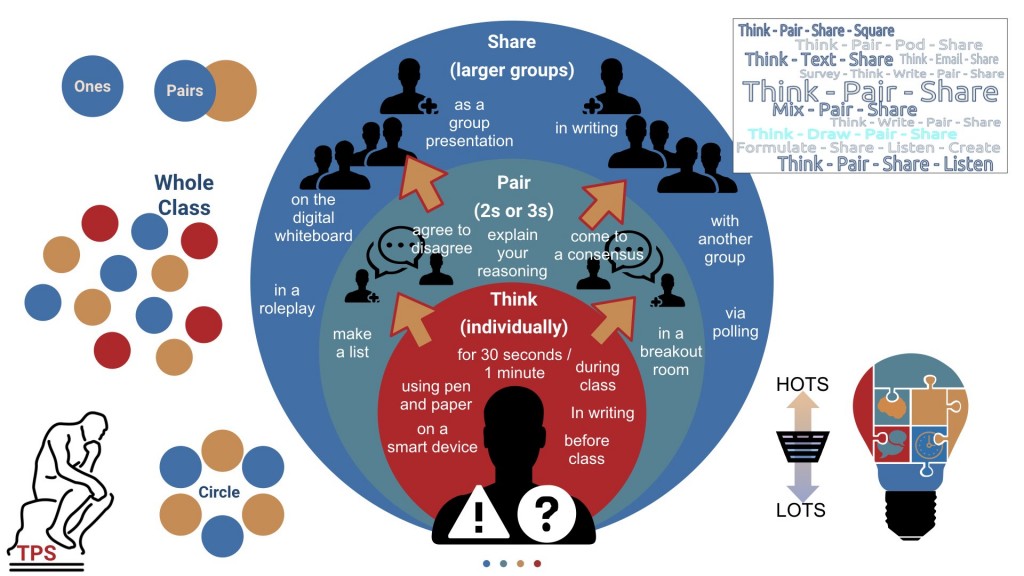PLAs #4 – Think, Pair, Share (TPS)
Think-Pair-Share (TPS) is the Swiss Army Knife of activities. This can, and should, be used often in your class.
In the first step, because learners need time to process information on their own, you need to allot some time for them to think about your challenge. It can be a one-minute thinking period, or it can be much longer, all depending on what they are thinking about. Given them this quiet time to work on their thinking skills. This takes practice, but if you use TPS often, it will quickly become a routine part of class.
The next step is crucial, and something that you will need to push yourself to do, as most instructors want immediate answers from their learners. Give them time, then, to pair up with someone else, and share their thoughts…whether it’s a single peer, or better, in a small group of three or four. You might have them do this several times in one class period, so they work on refining their responses. This also allows for full class participation at all times, and your have the luxury of joining smaller groups and doing more specialised, just-in-time instruction and formative feedback.
The final step is to do what is most traditional: have learners share what their discussions were about in front of the entire class. This is actually a bit different from the old teacher-student, teacher-student, teacher-student exchange from the days of yore. In the share part, learners are summarising their group discussions, which of course lowers their affective filters. There’s less fear if a learner response is what their group said. They are committed to answers that are shared among several peers.
Your main job at this point is to paraphrase their answers and check with other learners and their groups, to see let them evaluate their peers’ responses.
The illustration here shows many different ways to configure each of the three stages in TPS, and suggests several other variations on the theme. This can and should be one of the most used and reconfigurable participatory learning activities that you can do in your class, and it will yield higher intrinsic motivation, deeper learning responses, and a more reflective student population showing higher order critical thinking and creative skills, which is, of course, what we are all aiming for with our learners.
Name: Think-Pair-Share
Activity type: Discussion after a period of reflection
HOTS: Learners enhance their critical thinking skills, group facilitation skills, and lower their affective filters.
Grouping: Best to start with ONES. Let every individual learner get a chance to reflect deeply on what they are learning before they move on to working with others.
Online tool: Breakout rooms in Zoom or Collaborate Ultra will facilitate this activity, and you can easily randomise the number of participants in each room, and repopulate them quickly and easily.
This is the Top Ten Participatory Learning Activities (PLAs) Series. Each week, Dr. Larry Davies describes PLAs that are effective to use online. Your use of these PLAs will foster better learning and higher motivation in your learners. Each PLA contains an illustration that contains four elements:
- The name of the activity.
- Which one of the four types the activity is (that’s the lightbulb), including,
- Creative/critical thinking activity (inside the lightbulb, top left – the brain);
- Small group conversational activity (bottom left – the speech bubbles);
- Exit activity (given at the end of a lesson, unit, or project) (top right – the exit sign);
- Timed activity (where learners are under pressure to complete it within minutes) (bottom left – the clock).
- Whether it’s a Higher or Lower Order Thinking Skills Activity (HOTS or LOTS) (the HOTS/LOTS lever with “the pail”).
- A suggested grouping to maximize the benefit of the activity (the circles arranged in many ways).
Also, the description will contain suggestions for one or more online tools you can use with the PLA.
Previous blogs in this series include:
Subscribe to our Newsletter
Recent Posts
Teaching infographics #2 – VOCAL: Traits of a Successful Online Teacher
This graphic is a quick guide for some common s...10 routines for teaching online – #4 Talk types
The idea of ‘talk types’ is loosely...
Differentiating Instruction in Your LMS
Anyone who has been in the world of education f...
Authors
- Andy Steele (9)
- Azim Ahmed (12)
- Christine Lampe (3)
- Gemma Escott (1)
- Larry Davies (25)
- Mahinour Ezzat (1)
- Raghad Nihlawi (16)
- Samantha McDonald Amara (16)
- Sarah Whittaker (55)
- Silishi Noushad (1)
Categories
- Adult Learning
- Assessment
- Blackboard
- Blackboard
- BookWidgets
- Collaborate Ultra
- Ed Tech
- Grade Center
- ILC
- Infographics
- Instruction
- Learning Technology Tools
- Microsoft
- Mobile OS
- Mobile Technology
- Nearpod
- News & Events
- PLAs
- Professional Development
- Routines
- Teaching with Technology
- Uncategorized
- Webinars
Tag Cloud
Archives
- February 2021
- November 2020
- October 2020
- September 2020
- August 2020
- July 2020
- June 2020
- May 2020
- April 2020
- March 2020
- February 2020
- January 2020
- December 2019
- November 2019
- October 2019
- September 2019
- August 2019
- June 2019
- May 2019
- April 2019
- March 2019
- February 2019
- March 2016
- January 2016
- November 2015
- October 2015
- June 2015
- May 2015
- March 2015
- February 2015
- January 2015
- November 2014
- October 2014
- September 2014
- August 2014
- June 2014
- May 2014
- April 2014
- March 2014
- February 2014
- January 2014
- September 2013
- January 2013
- December 2012
- November 2012
- October 2012
- July 2012
- April 2012
- March 2012

